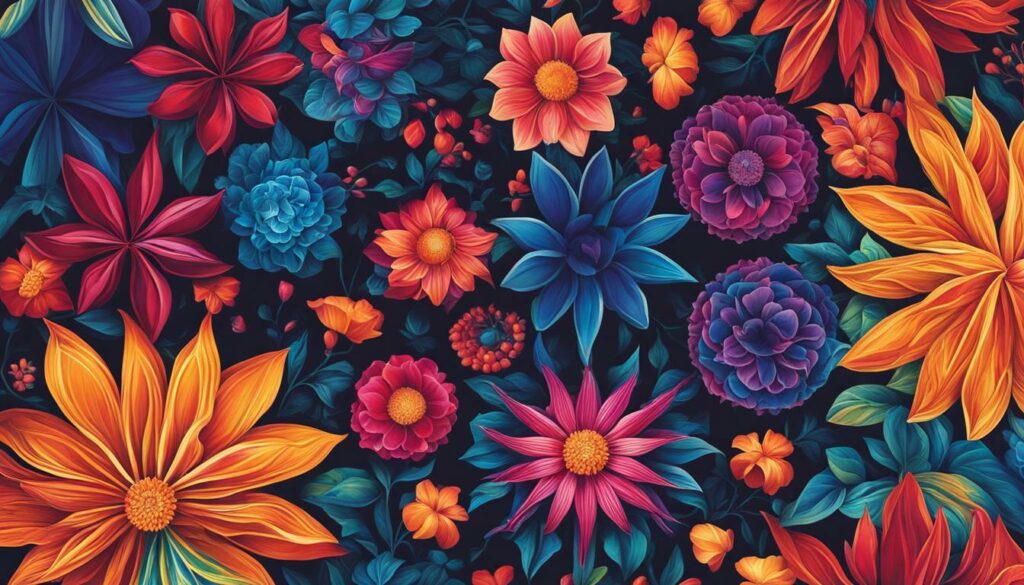Are you seeking a natural and non-invasive way to relieve pain? Color therapy, also known as chromotherapy, offers a holistic approach to pain management that harnesses the power of different colors.
Key Takeaways
- Color therapy, or chromotherapy, uses color and light to treat mental and physical health conditions.
- Different colors have different energies and can impact the body in various ways.
- Red energizes and stimulates, while blue is used for depression and pain relief.
- Green promotes relaxation and relieves stress, while yellow improves mood and optimism.
- Orange stimulates appetite and mental activity, while violet encourages spiritual guidance and creativity.
Understanding Color Therapy for Pain Relief
Color therapy, or chromotherapy, is based on the understanding that colors have distinct energies and can influence both physical and emotional well-being. This alternative therapy has been used for centuries by ancient cultures such as the Mayans, Indians, Egyptians, and Greeks. By harnessing the power of different colors, color therapy aims to promote healing and provide relief from pain.
One of the main benefits of color therapy is its ability to reduce pain and promote relaxation. Different colors have different effects on the body, and each color is associated with specific properties and emotions.
“Color therapy can be a powerful tool for pain relief, as it taps into the psychological and emotional impact of colors on our well-being,” says Dr. Sarah Johnson, a holistic practitioner specializing in color therapy. “For example, blue is known to have a calming effect and can help alleviate physical and emotional pain. Green is associated with balance and harmony, making it beneficial for reducing stress and promoting relaxation.”
| Color | Effects |
|---|---|
| Red | Energizing and stimulating |
| Blue | Depression and pain relief |
| Green | Relaxation and stress relief |
| Yellow | Mood improvement and optimism |
| Orange | Appetite stimulation and mental activity |
| Violet | Spiritual guidance and creativity |
Light therapy, a form of color therapy, has gained recognition in medical settings for its pain-relieving and healing properties. It has been used to treat a range of conditions, including chronic pain, depression, immune disorders, and seasonal affective disorder. Light therapy works by exposing the body to specific wavelengths of light, which can help reduce inflammation, promote blood circulation, and induce relaxation.
While the scientific evidence supporting color therapy is still limited, many individuals have reported positive results from incorporating color therapy into their holistic pain management strategies. By consulting with a healthcare provider and integrating color therapy as a complementary approach alongside traditional medical treatment, individuals may find relief from pain and enhance their overall well-being.

- McTaggart, L. (1992). Color and Healing: How to Use Color to Heal Your Body and Your Life. Avon Books.
- Zhai, J., Yao, Y., & Li, L. (2018). The therapeutic mechanisms and clinical effectiveness of light therapy for mood disorders: A review of the literature. Journal of Affective Disorders, 227, 163-177.
Exploring the Healing Powers of Colors
Each color holds its own healing power. Let’s dive into the various colors used in color therapy and how they can aid in pain relief.
Red: This vibrant color is known for its energizing and stimulating qualities. It can help to increase circulation, stimulate the senses, and provide relief from fatigue and physical exhaustion. Red is often used in color therapy to promote vitality and boost energy levels.
Blue: On the other end of the color spectrum, blue is associated with calmness and tranquility. It is often used to reduce pain and inflammation, making it beneficial for chronic pain sufferers. Blue is also known to have a soothing effect on the mind, promoting feelings of relaxation and mental clarity.
Green: Nature’s color, green is often used in color therapy to promote balance and harmony. It has a calming effect on the nervous system, reducing stress and anxiety. Green is also believed to aid in physical healing, as it is associated with regeneration and renewal.

| Color | Healing Properties |
|---|---|
| Red | Energizing, stimulating, vitality |
| Blue | Calmness, pain relief, mental clarity |
| Green | Balance, harmony, stress reduction |
| Yellow | Mood improvement, optimism, mental focus |
| Orange | Appetite stimulation, creativity, mental activity |
| Violet | Spiritual guidance, creativity, inspiration |
Yellow: Known as the color of happiness and sunshine, yellow is believed to improve mood and boost optimism. It can also enhance mental focus and clarity, making it a helpful color for those experiencing mental fatigue or lack of concentration.
Orange: This vibrant and energetic color is often used to stimulate appetite and mental activity. It is believed to inspire creativity and encourage social interaction. Orange can also provide a sense of warmth and comfort, making it a popular choice in color therapy.
Violet: With its association with spirituality and higher consciousness, violet is often used for spiritual guidance and inspiration. It is believed to stimulate creativity and enhance intuition. Violet can also have a calming effect on the mind and help to reduce anxiety and stress.
Color therapy techniques can vary, but they often involve exposure to specific colors through light, visualization, or the use of colored objects. By harnessing the healing power of colors, color therapy aims to promote balance, harmony, and overall well-being.
The Role of Light Therapy in Pain Management
Light therapy, a subset of color therapy, has gained recognition for its potential to provide pain relief and promote healing for various conditions. This therapy involves the use of specific wavelengths of light to stimulate the body’s natural healing mechanisms and restore balance. Light therapy can be a non-invasive and drug-free alternative for those seeking relief from chronic pain.
One of the main benefits of light therapy is its ability to reduce pain and inflammation. Studies have shown that exposure to certain wavelengths of light can activate cellular processes that help to reduce pain signals and decrease inflammation in the body. This can be particularly beneficial for individuals with conditions such as arthritis, fibromyalgia, or sports injuries.
Moreover, light therapy has been found to accelerate wound healing. By stimulating the production of collagen and promoting blood circulation, light therapy can aid in the regeneration of damaged tissues and expedite the healing process. This makes it a valuable tool for individuals recovering from surgeries or dealing with chronic wounds.
Another important aspect of light therapy is its ability to induce relaxation and improve overall well-being. The gentle glow of light can have a calming effect on the mind and body, helping to reduce stress and anxiety. This can be particularly beneficial for individuals experiencing chronic pain, as it can alleviate tension and improve sleep quality, ultimately enhancing their quality of life.
| Benefits of Light Therapy in Pain Management |
|---|
| Reduces pain and inflammation |
| Accelerates wound healing |
| Induces relaxation and reduces stress |
| Promotes overall well-being |
While light therapy shows promise as a safe and effective pain management technique, it’s important to note that individual results may vary. It is recommended to consult with a healthcare provider before incorporating light therapy into your pain management routine, especially if you have any underlying health conditions or are currently undergoing treatment for a specific ailment.
In conclusion, light therapy, as a part of color therapy, offers a non-invasive approach to pain management. Its potential for pain relief, wound healing acceleration, relaxation induction, and overall improvement of well-being makes it an appealing option for those seeking alternative pain management techniques. However, it is crucial to consult with a healthcare professional and receive personalized guidance before beginning any new therapy.

Integrating color therapy into your pain management routine can be a beneficial complementary approach to traditional medical treatment. Color therapy, also known as chromotherapy, harnesses the power of different colors to stimulate healing and promote overall well-being. By understanding the unique properties of each color and how they can impact our physical and mental health, we can use color therapy as a tool for pain relief and improved quality of life.
One way to incorporate color therapy into your daily routine is through the use of color visualization. By visualizing specific colors in your mind or surrounding yourself with those colors, you can tap into their energetic qualities. For example, if you’re experiencing chronic pain, you may want to visualize soothing blue or green colors that are known for their calming and pain-relieving properties. You can also incorporate these colors into your environment by using colored lights, fabrics, or decor.
Another effective way to use color therapy is through color bathing or light therapy. This involves exposing your body to specific colors of light to stimulate healing and relaxation. Light therapy devices are available for home use and can target specific areas of pain or provide overall body rejuvenation. By immersing yourself in the healing energy of color, you can experience relief from pain and promote a sense of balance and well-being.

| Health Condition | Recommended Color(s) |
|---|---|
| Chronic Pain | Blue, Green |
| Anxiety | Blue, Violet |
| Depression | Yellow, Orange |
| Stress | Green, Yellow |
Color therapy can be especially beneficial for individuals with specific health conditions. For chronic pain, blue and green colors are often recommended. Blue is known for its calming and cooling effects, while green promotes relaxation and balance. Those dealing with anxiety may find relief through blue and violet colors, which can help to soothe the mind and promote a sense of calm. For depression, yellow and orange colors are believed to uplift mood and increase optimism. And for stress management, green and yellow colors are commonly used to restore balance and reduce tension.
It’s important to remember that color therapy should not replace medical treatment, but rather be used as a complementary therapy. If you’re considering color therapy for pain relief or any other health condition, it’s always best to consult with a healthcare provider who can provide guidance and ensure it aligns with your overall treatment plan.
By incorporating color therapy into your pain management routine, you can tap into the healing power of color and promote your well-being from within. So why not give it a try? Embrace the beauty and energy of color and let it guide you on your journey to pain relief and a more vibrant life.
The Science Behind Color Therapy
While the scientific evidence for color therapy is still limited, many individuals have reported positive effects on their mood and overall well-being. Color therapy, also known as chromotherapy, is based on the belief that different colors have distinct energies and can impact the body’s physical and mental states.
In color therapy, each color is thought to have specific properties and effects on the body. For example, red is believed to be energizing and stimulating, while blue is used for pain relief and alleviating depression. Green is associated with relaxation and stress relief, while yellow is known to improve mood and boost optimism. Orange is used to stimulate appetite and mental activity, while violet is connected to spiritual guidance and creativity.
Light therapy, a form of color therapy, has been utilized in medical settings to treat a variety of conditions, including chronic pain, depression, immune disorders, and seasonal affective disorder. It has been observed to reduce swelling, relieve pain, promote wound healing, improve circulation, and induce relaxation.
Although color therapy is not widely recognized in Western medicine, many people have experienced the effects of color on their well-being. While there is limited scientific evidence, color therapy is considered a harmless and potentially beneficial complementary therapy for pain relief and various health conditions.

| Color | Properties | Effects |
|---|---|---|
| Red | Energizing and stimulating | Increases energy levels |
| Blue | Calming and pain-relieving | Reduces pain and alleviates depression |
| Green | Relaxing and stress-relieving | Promotes relaxation and relieves stress |
| Yellow | Mood-enhancing and optimistic | Improves mood and boosts optimism |
| Orange | Stimulating and mentally invigorating | Stimulates appetite and mental activity |
| Violet | Spiritual and creative | Associated with spiritual guidance and creativity |
Important Considerations for Color Therapy
Before incorporating color therapy into your pain management regimen, it’s crucial to consult with a healthcare provider to ensure it aligns with your overall treatment plan. While color therapy can be a complementary therapy for pain relief and other health conditions, it should not replace medical treatment. Here are some important considerations to keep in mind:
- Personalized Approach: Color therapy is not a one-size-fits-all solution. Different colors may have different effects on individuals, and it’s important to find the right colors that work for you and your specific health condition. Your healthcare provider can help determine which colors are most suitable for your needs.
- Integration with Medical Treatment: Color therapy should be used in conjunction with traditional medical treatment. It is not a standalone therapy and should not be relied upon as the sole method of pain management. Your healthcare provider can guide you on how to incorporate color therapy into your overall treatment plan.
- Individual Sensitivities and Reactions: Just like any form of therapy, some individuals may be more sensitive to the effects of color therapy than others. It’s important to pay attention to how you feel during and after color therapy sessions and communicate any discomfort or adverse reactions to your healthcare provider.

Color therapy can be a harmless and potentially beneficial complementary therapy, but it’s essential to consult with a healthcare provider before integrating it into your pain management regimen.
Conclusion
While color therapy may not have widespread acceptance in Western medicine, many individuals have found it to be a helpful tool in managing pain and promoting overall well-being. Its non-invasive nature and potential benefits make it worth exploring as a complementary therapy. However, it’s important to remember that color therapy should never replace medical treatment and should only be used under the guidance of a healthcare provider.
| Key Considerations for Color Therapy |
|---|
| Consult with a healthcare provider |
| Integrate it with medical treatment |
| Pay attention to individual sensitivities |
Embracing Color Therapy for Pain Relief
Discover the power of color therapy for natural pain relief and embrace a holistic approach to managing your pain. Color therapy, also known as chromotherapy, has been used for centuries in various cultures around the world. It harnesses the energy of different colors to promote physical and mental well-being. By incorporating color therapy into your pain management routine, you can explore alternative and non-invasive methods that may complement traditional medical treatments.
Color therapy believes that different colors have unique energies that can impact our bodies in different ways. For example, red is known for its energizing and stimulating properties, while blue is often used to alleviate depression and relieve pain. Green is associated with relaxation and stress relief, and yellow can enhance mood and optimism. Orange stimulates appetite and mental activity, while violet is believed to foster spiritual guidance and creativity.
One form of color therapy is light therapy, which involves exposure to specific colors of light to promote healing and well-being. This technique has been used in medical settings to treat various conditions, including chronic pain, depression, and immune disorders. It has shown promising results in reducing inflammation, alleviating pain, accelerating wound healing, improving blood circulation, and inducing relaxation.
While color therapy is not widely recognized in Western medicine, many individuals have personally experienced the transformative effects of color on their mood and overall well-being. Although scientific evidence for color therapy is still limited, it is considered a harmless complementary therapy that may offer potential benefits for pain relief and various health conditions. However, it is crucial to remember that color therapy should never replace medical treatment, and consulting with a healthcare provider is essential before incorporating it into your pain management regimen.
FAQ
What is color therapy?
Color therapy, also known as chromotherapy, is a form of therapy that uses color and light to treat certain mental and physical health conditions. It is based on the idea that different colors have different energies and can impact the body in various ways.
What are the different effects that colors can have on the body?
Different colors are believed to have different effects on the body. Red is considered energizing and stimulating, blue is used for depression and pain relief, green promotes relaxation and relieves stress, yellow improves mood and optimism, orange stimulates appetite and mental activity, and violet is associated with spiritual guidance and creativity.
How is light therapy used in color therapy?
Light therapy, a form of color therapy, has been used in medical settings to treat various conditions such as chronic pain, depression, immune disorders, and seasonal affective disorder. It has been reported to reduce swelling, relieve pain, accelerate wound healing, improve circulation, and promote relaxation.
Is there scientific evidence for color therapy?
While the scientific evidence for color therapy is still limited, many people have experienced the ways in which color can affect their mood and well-being. Color therapy can be a harmless and potentially beneficial complementary therapy for pain relief and other health conditions.
Can color therapy replace medical treatment?
No, color therapy should not replace medical treatment. It is important to consult with a healthcare provider before using color therapy for any health condition. Color therapy should be used as a complementary approach alongside traditional medical treatment.




